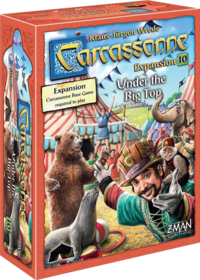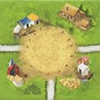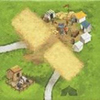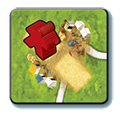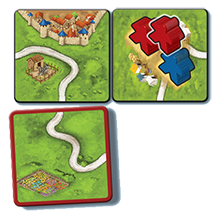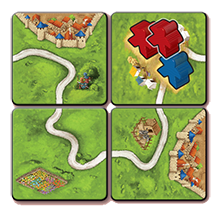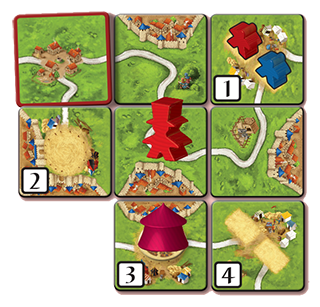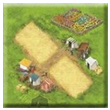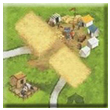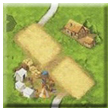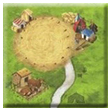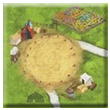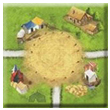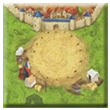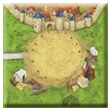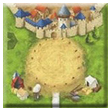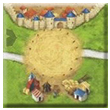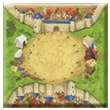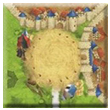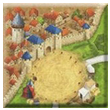Cyrk objazdowy
 |
You are reading the rules for this tile design. |  |
| This expansion was not published in other editions. |
| If your tiles have a different design, then choose a game from Spin-offs. |  |
A circus travels from place to place with its animals. When it pitches its big top, all the meeples in the vicinity flock to admire the attractions. Acrobats are true masters of their trade. As soon as they find a suitable spot, they pile up to form a "human" pyramid. And the ringmaster prefers to have acrobats or his big top around him. Only then does he really thrive. Come and be amazed!
General info and comments
Under the Big Top was released by HiG in 2017.
This expansion doesn't exist for the 1st edition (C1 for short).
You can integrate this entire expansion into the game, or only parts of it if you choose. You can also combine this expansion with any other Carcassonne expansions.
New features/elements:
- Ringmasters, a meeple that provides additional points
- The big top, a neutral figure that moves around the playing area providing additional points
- Animal tokens, that are placed under the big top to decide the scoring
- Circus spaces, a feature where the big top can be placed
- Acrobat spaces, a feature where acrobat pyramids can be built
Contents
- 20 Land tiles including
- 12 Circus tiles with one circus space each
- 8 Acrobat tiles with two acrobat spaces each
- 16 Animal tokens: 1 Elephant, 2 Tigers, 3 Bears, 5 Seals, 4 Monkeys, 1 Flea
- 1 Big Top
- 6 Ringmasters, 1 in each color
Rules
Preparation
Shuffle the 20 new Land tiles with those from the base game (and any other expansions you wish to use). Shuffle the 16 Animal tokens and place them in a facedown stack within easy reach of all players. Place the Big Top near the stack of Animal tokens. Finally, players add the Ringmaster in their color to their supply of meeples.
Circus tiles, animal tokens and the big top
1. Placing a tile
Circus tiles are placed like normal Land tiles.
Special case: When the first Circus tile is placed, take the top Animal token from the stack, place it facedown on the circus space, and place the Big Top on it. From this point on, the Big Top moves only when a player places a new Circus tile (after 3. Scoring a feature).
2. Placing a meeple
After placing a Circus tile, you can place a meeple on it as a highwayman, a knight, or a farmer as usual. However, you cannot place a meeple on the circus space.
3. Scoring a feature
Whenever you place another Circus tile during the game:
1) Score any features that were completed when the Circus tile was placed (and return the meeples scored to their owners' supply). [1]
2) Then score the circus on the Big Top’s current tile:
First reveal the Animal token on which the Big Top stands. Then, you and the other players will score points for the meeples on the Circus tile itself and the eight surrounding tiles. Each meeple will be worth the value on the revealed Animal token. [2]
Note: Ringmasters and acrobats (see below) also count as meeples so, if they occupied a space surrounding the Big Top when scoring the circus, they would score points. [3]
Important: When scoring the circus, the meeples involved are not returned to their owner's supply. Instead, they stay on their tile.
3) After scoring the circus, remove the Animal token from the game by placing it faceup next to the scoreboard. Finally, take the top Animal token from the stack, place it facedown on the new circus space, and place the Big Top on it.
Game end
At the end of the game before final scoring, score the circus one last time.
Note on circus spaces
Circus spaces close roads and separate fields from each other.
Acrobat tiles
1. Placing a tile
Acrobat tiles are placed like normal Land tiles.
2. Placing a meeple
After placing an Acrobat tile, you can place your meeple on the road or in the field, as usual.
You also have another option: you can place your meeple as an acrobat on one of the two acrobat spaces.
On a later turn, if you place a tile adjacent to one or more Acrobat tiles (horizontally, vertically, or diagonally), you may place a meeple as an acrobat on one of those Acrobat tiles. [4]
If the two acrobat spaces are already occupied, you can add a third meeple on the shoulders of the other two meeples. At that point, the pyramid is complete, and no more meeples can be added to it.
The color of the meeples in the pyramid does not matter. Pyramids can have meeples of one, two, or three colors.
If you place an Acrobat tile adjacent to one or more Acrobat tiles and you wish to place a meeple as an acrobat, choose on which of those Acrobat tiles to place your acrobat.
3. Scoring a feature
When there are three acrobats in a pyramid, it is ready to be scored. However, pyramids are not scored immediately after completion because the acrobats wish to display their skills for a little while.
Instead of placing a meeple or any other figure during 2. Placing a meeple, you can score a completed pyramid. Each acrobat in the completed pyramid is worth 5 points. Then return the scored meeples to their owners' supply. [5]
Additional rules:
- After a pyramid has been scored, players can start a new pyramid on the same tile by placing acrobats on it again.
- You can score a completed pyramid even if you have no acrobats in it.
Game end
During final scoring, each of your acrobats is worth 5 points, regardless of the pyramid’s size.
Note on acrobat spaces
Acrobat spaces close roads and separate fields from each other.
The ringmaster
2. Placing a meeple
You can place your ringmaster (instead of a normal meeple) on an unoccupied feature on the tile just placed: on a road, in a city or a monastery, or lay him down in a field. The ringmaster counts as a normal meeple in all cases except that it cannot be used as an acrobat.
3. Scoring a feature
If the feature with your ringmaster becomes completed, first score points for the completed feature.
Then, for each Circus and Acrobat tile that your ringmaster is on or adjacent to, score 2 points. You also score these ringmaster points even if your ringmaster did not score any points from the completed feature (e.g., someone else had majority). The Big Top and acrobats in a pyramid do not affect ringmaster points. After scoring, return the ringmaster to your supply.
Game end
At the end of the game, ringmasters score fields or incomplete features as normal meeples and also score ringmaster points.
Other expansions
This section contains additional information about the interactions with other Carcassonne expansions.
![]() When scoring a circus, these figures score points:
When scoring a circus, these figures score points:
- Normalny podwładny (
 Gra podstawowa)
Gra podstawowa) - Opat (Gra podstawowa -
 Opat)
Opat) - Duży podwładny (
 Rozszerzenie 1. - Karczmy i katedry)
Rozszerzenie 1. - Karczmy i katedry) - Wóz (
 Rozszerzenie 5. - Opactwo i burmistrz)
Rozszerzenie 5. - Opactwo i burmistrz) - Burmistrz (
 Rozszerzenie 5. - Opactwo i burmistrz)
Rozszerzenie 5. - Opactwo i burmistrz) - Dyrektor cyrku (
 Rozszerzenie 10. - Cyrk objazdowy)
Rozszerzenie 10. - Cyrk objazdowy) - Strażnik (
 Rozszerzenie 11. - Duchy, pałace i cmentarze)
Rozszerzenie 11. - Duchy, pałace i cmentarze) - Świta (
 Świta)
Świta)
![]() Any of these meeples can be considered for circus scoring when:
Any of these meeples can be considered for circus scoring when:
- It is on a tile surrounding the circus. There is no restriction about their role or position: the meeple can be placed on a feature on a neighboring tile (even if it placed as an abbot), placed on a tower, or trapped (in a bathhouse, on the Vodyanoy tile, or the Solovei Razboynik tile).
- It is in a castle overlapping any of the tiles surrounding the circus.
![]() Any of these meeples cannot be considered for circus scoring when placed on special areas not considered on a particular tile: The city of Carcassonne, the city of Leipzig (by analogy), or the Wheel of Fortune.
Any of these meeples cannot be considered for circus scoring when placed on special areas not considered on a particular tile: The city of Carcassonne, the city of Leipzig (by analogy), or the Wheel of Fortune.
![]() When scoring a circus, these figures DO NOT score points:
When scoring a circus, these figures DO NOT score points:
![]() A meeple placed on a tower will receive points when scoring a neighboring circus, the same as any meeple placed on the same tile.
A meeple placed on a tower will receive points when scoring a neighboring circus, the same as any meeple placed on the same tile.
![]() Rozszerzenie 8. - Mosty, zamki i bazary
Rozszerzenie 8. - Mosty, zamki i bazary
![]() You can build a bridge on a Circus tile (with or without the Big Top) following the normal rules.
You can build a bridge on a Circus tile (with or without the Big Top) following the normal rules.
![]() If at least one tile forming a castle is adjacent to the Big Top, a meeple in that castle will score points when a circus is scored.
If at least one tile forming a castle is adjacent to the Big Top, a meeple in that castle will score points when a circus is scored.
![]() A meeple placed on a bridge will receive points when scoring a neighboring circus, the same as any meeple placed on the same tile.
A meeple placed on a bridge will receive points when scoring a neighboring circus, the same as any meeple placed on the same tile.
![]() At the end of the game, the last circus scoring should be carried out before removing any remaining castle lord from the playing area.
At the end of the game, the last circus scoring should be carried out before removing any remaining castle lord from the playing area.
![]() Klasztory w Niemczech /
Klasztory w Niemczech / ![]() Klasztory w Holandii i Belgii /
Klasztory w Holandii i Belgii / ![]() Japońskie Budowle
Japońskie Budowle
![]() A meeple placed as an abbot on a special monastery will receive points when scoring a neighboring circus, the same as any meeple placed on the same tile.
A meeple placed as an abbot on a special monastery will receive points when scoring a neighboring circus, the same as any meeple placed on the same tile.
![]() A meeple placed on any feature on a German castle tile will receive points when scoring a neighboring circus.
A meeple placed on any feature on a German castle tile will receive points when scoring a neighboring circus.
![]() A meeple trapped in a bathhouse will receive points when scoring a neighboring circus, the same as any meeple placed on the same tile.
A meeple trapped in a bathhouse will receive points when scoring a neighboring circus, the same as any meeple placed on the same tile.
![]() A meeple placed on any feature on a Halfling tile will receive points when scoring a neighboring circus.
A meeple placed on any feature on a Halfling tile will receive points when scoring a neighboring circus.
![]() A meeple trapped on the Vodyanoy tile or the Solovei Razboynik tile will receive points when scoring a neighboring circus.
A meeple trapped on the Vodyanoy tile or the Solovei Razboynik tile will receive points when scoring a neighboring circus.
![]() Only normal meeples can be part of a meeple pyramid. Neither the large meeple (Exp. 1) nor any other figures are allowed. [6]
Only normal meeples can be part of a meeple pyramid. Neither the large meeple (Exp. 1) nor any other figures are allowed. [6]
![]() Rozszerzenie 3. - Księżniczka i Smok
Rozszerzenie 3. - Księżniczka i Smok
![]() You may assign the fairy to an acrobat, in which case it counts for all acrobats in the pyramid (regardless of color). If the fairy is still there at the beginning of your turn, you score 1 point for each of your meeples in the pyramid. [7]
You may assign the fairy to an acrobat, in which case it counts for all acrobats in the pyramid (regardless of color). If the fairy is still there at the beginning of your turn, you score 1 point for each of your meeples in the pyramid. [7]
![]() The acrobats in a pyramid are not entitled to get the 3-point bonus from the fairy if next to any of those acrobats. [8]
The acrobats in a pyramid are not entitled to get the 3-point bonus from the fairy if next to any of those acrobats. [8]
![]() You can use a magic portal to place one of your meeples on an acrobat space/pyramid.
You can use a magic portal to place one of your meeples on an acrobat space/pyramid.
![]() If you capture an acrobat with the tower, you can choose any meeple in the pyramid (regardless of its position, that is, whether it is on top or on the bottom). [9]
If you capture an acrobat with the tower, you can choose any meeple in the pyramid (regardless of its position, that is, whether it is on top or on the bottom). [9]
![]() Rozszerzenie 8. - Mosty, zamki i bazary
Rozszerzenie 8. - Mosty, zamki i bazary
![]() You can build a bridge on an Acrobat tile only if no acrobats are on it, and you cannot place an acrobat on an Acrobat tile with a bridge on it.
You can build a bridge on an Acrobat tile only if no acrobats are on it, and you cannot place an acrobat on an Acrobat tile with a bridge on it.
![]() A meeple pyramid in a castle’s fief does not count as a "feature" that can cause a castle to score.
A meeple pyramid in a castle’s fief does not count as a "feature" that can cause a castle to score.
![]() You can use a flying machine to place one of your regular meeples on an acrobat space/pyramid.
You can use a flying machine to place one of your regular meeples on an acrobat space/pyramid.
![]() The ringmaster counts as a normal meeple. He has the same uses as a normal meeple in all expansions. [10]
The ringmaster counts as a normal meeple. He has the same uses as a normal meeple in all expansions. [10]
![]() You can place your ringmaster on a tower (even if it will be a little wobbly).
You can place your ringmaster on a tower (even if it will be a little wobbly).
![]() Rozszerzenie 5. - Opactwo i burmistrz
Rozszerzenie 5. - Opactwo i burmistrz
![]() If you use your ringmaster as a farmer, you score its ringmaster points in all cases (during final scoring, after a barn is placed in the ringmaster’s field, or after the ringmaster’s field is connected to a barn).
If you use your ringmaster as a farmer, you score its ringmaster points in all cases (during final scoring, after a barn is placed in the ringmaster’s field, or after the ringmaster’s field is connected to a barn).
Tile distribution
Przypisy
W celu zapoznania się z objeśnieniami ikon oraz licencjami odwiedź: Ikony.
- ↑
 This last sentence in brackets is present in the German rules but is omitted in the English version.
This last sentence in brackets is present in the German rules but is omitted in the English version.
 This action is implicit to the scoring but it is important to note that the meeples in the scored features will be removed before the big top is scored. Therefore those meeples will not be eligible for big top points.
This action is implicit to the scoring but it is important to note that the meeples in the scored features will be removed before the big top is scored. Therefore those meeples will not be eligible for big top points.
- ↑
 Note that each player scores the total points for all their meeples at once. There is no individual scoring per meeple.
Note that each player scores the total points for all their meeples at once. There is no individual scoring per meeple.
- ↑
 The rules by ZMG omitted to mention acrobats explicitly, unlike thoses by HiG.
The rules by ZMG omitted to mention acrobats explicitly, unlike thoses by HiG.
- ↑
 Note that you will not be able to add an acrobat to an incomplete pyramid if the Acrobat tile has no empty spaces adjacent to it. In this case, the meeples in the pyramid will stay there until the end of the game.
Note that you will not be able to add an acrobat to an incomplete pyramid if the Acrobat tile has no empty spaces adjacent to it. In this case, the meeples in the pyramid will stay there until the end of the game.
- ↑
 Note that each player scores the total points for all their acrobats at once. There is no individual scoring per meeple.
Note that each player scores the total points for all their acrobats at once. There is no individual scoring per meeple.
- ↑
 Even though the phantom is considered like a normal meeple, it's still a phantom. The rules state precisely that no other meeple can be put there, no exceptions. (6/2021)
Even though the phantom is considered like a normal meeple, it's still a phantom. The rules state precisely that no other meeple can be put there, no exceptions. (6/2021)
- ↑
 Note that you score the bonus points for your acrobats at once. There is no individual bonus scoring per meeple.
Note that you score the bonus points for your acrobats at once. There is no individual bonus scoring per meeple.
- ↑
 This restriction is not included explicitly in the rules (only the 1-point fairy bonus is mentioned) but it comes from the interpretation of the rules:
This restriction is not included explicitly in the rules (only the 1-point fairy bonus is mentioned) but it comes from the interpretation of the rules:
- During the game, acrobats are scored in phase 2. Placing a Meeple and players receive the 3-point fairy bonus when scoring completed features in phase 3. Scoring a feature. Since both actions take place in different phases, acrobats cannot receive this fairy bonus during the game.
- After the game, acrobats should not get the 3-point scoring bonus when scored for the sake of consistency. An acrobat pyramid is not a tile-based feature but a meeple-based scoring, so no feature is scored either at the end of the game in this case and no fairy bonus should be applied. (4/2020; updated 7/2020)
- During the game, acrobats are scored in phase 2. Placing a Meeple and players receive the 3-point fairy bonus when scoring completed features in phase 3. Scoring a feature. Since both actions take place in different phases, acrobats cannot receive this fairy bonus during the game.
- ↑
 This means that a tower may capture any meeple in an acrobat pyramid even if it is completed and awaiting scoring.
This means that a tower may capture any meeple in an acrobat pyramid even if it is completed and awaiting scoring.
- ↑
 This means you don't receive ringmaster points if you place it on features other than roads, cities, monasteries or fields. No other feature triggers the ringmaster bonus. (1/2021)
This means you don't receive ringmaster points if you place it on features other than roads, cities, monasteries or fields. No other feature triggers the ringmaster bonus. (1/2021)
 There is no official clarification about how to score the ringmaster bonus for any of these features on a double-sized tile.
There is no official clarification about how to score the ringmaster bonus for any of these features on a double-sized tile.
